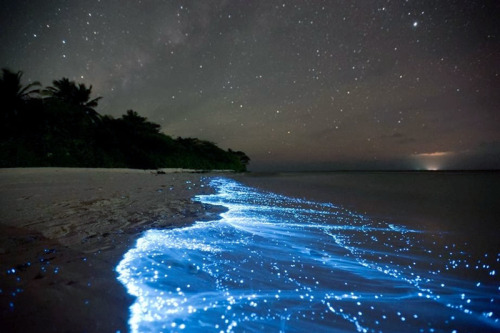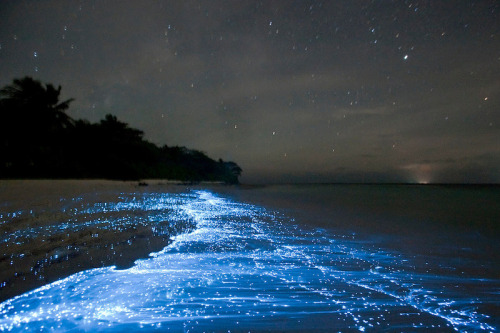By Eduardo Flores




by Eduardo Flores
More Posts from Starry-shores and Others

The Sun from the Internation Space Station
Dunkleosteus

Dunkleosteus, a placoderm, or armoured, fish. It lived around 370 million years ago, during the Devonian period and is arguably the biggest predator of its time. This was a truly impressive fish, literally hard as nails, its head was encased in a solid armour plating and like a shark, it had a streamlike body to swiftly move through the water. Its heavy armour means it would’ve been a relatively slow swimmer, yet capable of short spurts of speed, sort of like some sharks today.
This formidable beast had a major evolutionary strength, a moveable jaw. Fish began to dominate the oceans when they evolved the ability to move their jaw, yet Dunkleosteus had no teeth, what it had was much more menacing. It had razor like blades to slice its prey apart, like a pair of scissors to paper, with a bite more powerful than a great white. It would’ve been able to slice its prey in half so it was able to consume huge animals, yet on the downside the Dunkleosteus was unable to chew and on occasion its stomach found the huge chunks of meat hard to handle, evidence of this is in fossilised sick of the Dunkleosteus that has been found…

(Dunkleosteus armour means its head is often very well preserved. You can see how its teeth would’ve been more than capable of shearing through flesh.)
Relatives of the dunkleosteus, other armoured fish, were mostly dog sized, but Dunkleosteus was an exception. At 6 metres long on average, twice the length of human, this was a seriously big fish, yet it could reach up to 10 metres long, the length of a bus.

Dunkleosteus seems like the perfect predator. However, in its bony plates, indents of other animal teeth have been found suggesting that despite its strength, it was itself hunted. Dunkloesteus teeth marks have been found in its own fossils, they would eat whatever they could get their teeth into, including each other. The success of this gigantic beast was short lived, it was outcompeted by the more nimble sharks. Placoderm fish themselves would be extinct by the end of the devonian, taking the Dunkleosteus with it.

The Himalayan plateau, as seen from the ISS by europeanspaceagency


Sea of Stars, Vaadhoo Island, Maldives by Doug Perrine
Dear @thought-cafe team, we need more Crash Course Astronomy episodes! Can you please do a Season 2? Dr. Phil Plait is awesome, and we miss him!

If you’re excited about the juno news today, sink your teeth into a Crash Course episode that’s all about Jupiter! 🔭 https://youtu.be/Xwn8fQSW7-8

Plesiosaurus skeleton from the Houston Natural History Museum!

Daphnis and the Rings of Saturn : What’s happening to the rings of Saturn? A little moon making big waves. The moon is 8-kilometer Daphnis and it is making waves in the Keeler Gap of Saturn’s rings using just its gravity – as it bobs up and down, in and out. The featured image is a colored and more detailed version of a previously released images taken in 2017 by the robotic Cassini spacecraft during one of its Grand Finale orbits. Daphnis can be seen on the far right, sporting ridges likely accumulated from ring particles. Daphnis was discovered in Cassini images in 2005 and raised mounds of ring particles so high in 2009 – during Saturn’s equinox when the ring plane pointed directly at the Sun – that they cast notable shadows. via NASA
-
 airheadsphotographyfromsaturn reblogged this · 2 years ago
airheadsphotographyfromsaturn reblogged this · 2 years ago -
 eternah-paz liked this · 2 years ago
eternah-paz liked this · 2 years ago -
 eternah-paz reblogged this · 2 years ago
eternah-paz reblogged this · 2 years ago -
 grasses-under-my-feet reblogged this · 2 years ago
grasses-under-my-feet reblogged this · 2 years ago -
 blog637363 liked this · 2 years ago
blog637363 liked this · 2 years ago -
 megtortenhetne liked this · 2 years ago
megtortenhetne liked this · 2 years ago -
 torjanp reblogged this · 2 years ago
torjanp reblogged this · 2 years ago -
 kostusha liked this · 2 years ago
kostusha liked this · 2 years ago -
 avantsympathy reblogged this · 2 years ago
avantsympathy reblogged this · 2 years ago -
 silverdaddiesparty liked this · 3 years ago
silverdaddiesparty liked this · 3 years ago -
 eventhebestdayhasastorm reblogged this · 3 years ago
eventhebestdayhasastorm reblogged this · 3 years ago -
 eventhebestdayhasastorm liked this · 3 years ago
eventhebestdayhasastorm liked this · 3 years ago -
 ohmywildheart reblogged this · 3 years ago
ohmywildheart reblogged this · 3 years ago -
 ohmywildheart liked this · 3 years ago
ohmywildheart liked this · 3 years ago -
 universethroughmymind liked this · 3 years ago
universethroughmymind liked this · 3 years ago -
 huseyinozdemirerk reblogged this · 3 years ago
huseyinozdemirerk reblogged this · 3 years ago -
 huseyinozdemirerk liked this · 3 years ago
huseyinozdemirerk liked this · 3 years ago -
 calafiorii liked this · 3 years ago
calafiorii liked this · 3 years ago -
 mayur-jhina reblogged this · 3 years ago
mayur-jhina reblogged this · 3 years ago -
 in-the-ferns reblogged this · 4 years ago
in-the-ferns reblogged this · 4 years ago -
 humanamentee liked this · 4 years ago
humanamentee liked this · 4 years ago -
 keno liked this · 4 years ago
keno liked this · 4 years ago -
 lothlorienfading reblogged this · 4 years ago
lothlorienfading reblogged this · 4 years ago -
 bagellife reblogged this · 4 years ago
bagellife reblogged this · 4 years ago -
 dreamsoffallingstars reblogged this · 4 years ago
dreamsoffallingstars reblogged this · 4 years ago -
 sincerelyvika reblogged this · 4 years ago
sincerelyvika reblogged this · 4 years ago -
 trouble-coupled-in-double reblogged this · 4 years ago
trouble-coupled-in-double reblogged this · 4 years ago -
 dangerousexpeditions liked this · 4 years ago
dangerousexpeditions liked this · 4 years ago -
 everydayisasaturday777 liked this · 4 years ago
everydayisasaturday777 liked this · 4 years ago -
 bumblebeesandsaltyseas reblogged this · 4 years ago
bumblebeesandsaltyseas reblogged this · 4 years ago -
 bagellife reblogged this · 4 years ago
bagellife reblogged this · 4 years ago -
 pampamtiger liked this · 4 years ago
pampamtiger liked this · 4 years ago -
 openaworldofrandomness liked this · 4 years ago
openaworldofrandomness liked this · 4 years ago -
 gdiminyoongi reblogged this · 4 years ago
gdiminyoongi reblogged this · 4 years ago -
 gdiminyoongi liked this · 4 years ago
gdiminyoongi liked this · 4 years ago -
 nyoongsgf reblogged this · 4 years ago
nyoongsgf reblogged this · 4 years ago -
 harikuladeee liked this · 4 years ago
harikuladeee liked this · 4 years ago -
 wesleyyayers liked this · 4 years ago
wesleyyayers liked this · 4 years ago -
 exploit-bubbles reblogged this · 4 years ago
exploit-bubbles reblogged this · 4 years ago -
 exploit-bubbles liked this · 4 years ago
exploit-bubbles liked this · 4 years ago -
 fruitypebbbls liked this · 4 years ago
fruitypebbbls liked this · 4 years ago -
 roadtoeboyado reblogged this · 4 years ago
roadtoeboyado reblogged this · 4 years ago -
 rustypipes-and-tigerstripes reblogged this · 4 years ago
rustypipes-and-tigerstripes reblogged this · 4 years ago

Amateur astronomer, owns a telescope. This is a side blog to satiate my science-y cravings! I haven't yet mustered the courage to put up my personal astro-stuff here. Main blog : @an-abyss-called-life
212 posts



